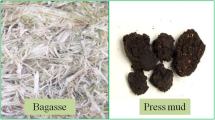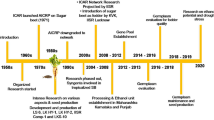Abstract
Climatic conditions of Jorhat, a high percentage of relative humidity and low termperature during January, February are highly favourable for the infection and yield of ergot at Jorhat. The best time of sowing rye is the first fortnight of October and artificial infection during January. Out of 15 strains ofClaviceps purpurea used in this study, the “ergometrine” strain and “ergotamine” strain, received from the University of Johannes, Gutenberg, Mainz, performed most efficiently under the condition at Jorhat, giving high yields of sclerotia and alkajoids. The sclerotia produced by these strains were also larger in size than the average.
Artificial infection with spore suspension in cane-sugar (4·5%) produced higher yields of sclerotia of larger size as compared with artificial infection with spore suspension in water. A method for the extraction of ergotamine and ergometrine from the sclerotia is described. Following this method of extraction, the yield of ergometrine and ergotamine obtained could be favourably compared with the yields reported by other workers. Good prospect of large-scale cultivation of ergot under the climatic conditions of Jorhat and extraction of alkaloids is indicated by the study.
Similar content being viewed by others
References
Biswas, K...Annual Report of the Ergot Cultivation Scheme in West Bengal, 1955–56 to 1958–59, West Bengal Govt. Press, Alipore, Calcutta.
British Pharmaceutical Codex, 1963.
Czech. Pat. 85, 995, 1956,Through Chem. Abst., 1958,52, 1560.
Gandotra, K. L. and Ganguly D.J. Sci. Industr. Res., 1962,21 D, 460.
Hynes, H. ..Agric. Gaz N.W.S. Misc. Publication No 3218, 1941, pp. 1–6.
Marudarajan, D., Ramakrishnan, T. S., Krishna Menon, K. and Srinivasan, K. V.Proc. Ind, Acad. Sci., 1950,31 B, 103.
Melville, J. ..Pharma J., 1941, 147, 4th Sec. 4073, 178 (R.A.M., 1942,21, 135).
Tuzson, J. and Vastagh, G.Acta Pharm. Hung., 1955,25, 8.Through Chem. Abst., 1958,52, 8467.
Vladimirsky, S. W...Sovetsk Bot., 1939,5, 77 (R.A.M., 1942,19, 209).
Zawisza, T. and Kucaynski, L. “Ion exchange separation of ergot alkaloids,”Acta Polon. Pharm., 1960,17, 117–30.Through Chem. Abst., 1960,54, 20087.
Author information
Authors and Affiliations
Additional information
Communicated by Dr. I. C. Chopra,f.a.sc.
Rights and permissions
About this article
Cite this article
Bordoloi, D.N., Rehana, F., Chaudhuri, S.B. et al. Experimental cultivation of ergot at Jorhat, Assam and extraction of alkaloids. Proc. Indian Acad. Sci. 73, 251–263 (1971). https://doi.org/10.1007/BF03045320
Received:
Issue Date:
DOI: https://doi.org/10.1007/BF03045320




